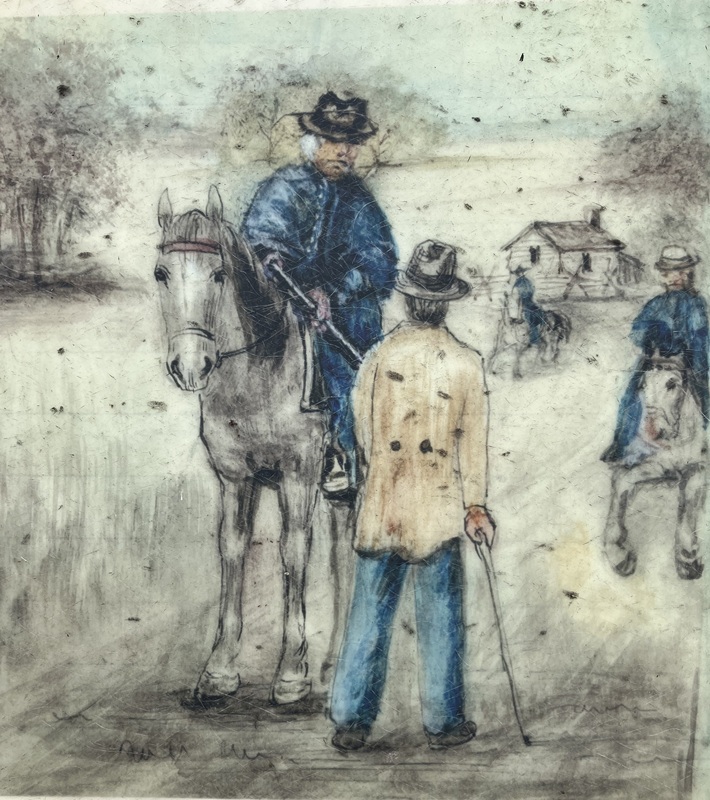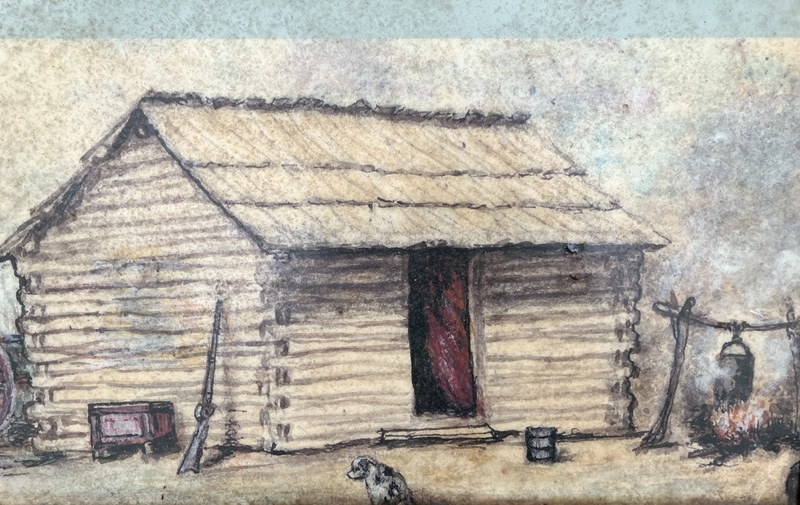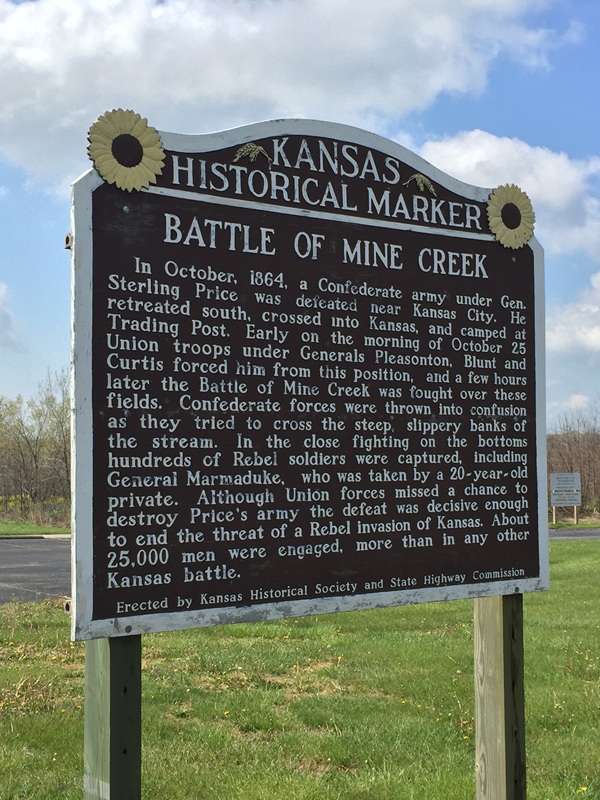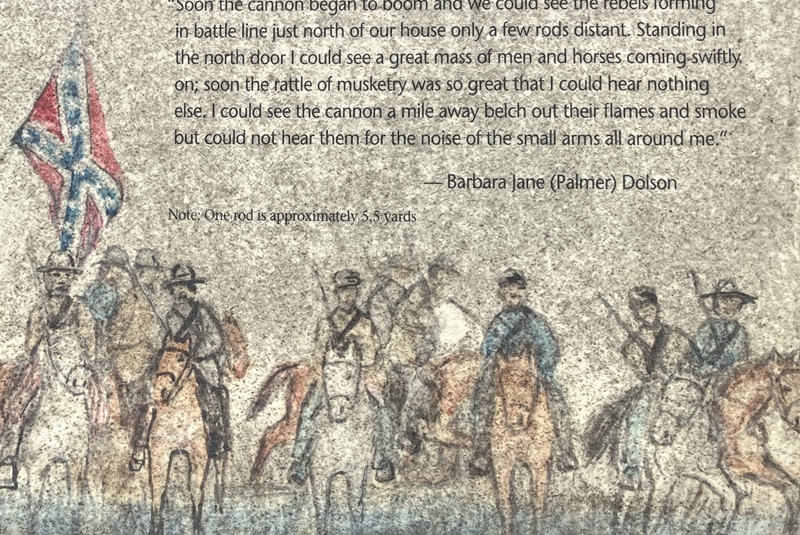The Art of War: Samuel Reader and the Battle of Mine Creek
ECW welcomes guest author Keith Moore.
He fought alongside abolitionist John Brown before serving in the Kansas State Militia as a second lieutenant and later paymaster of Company D. He was a diarist who kept a daily journal for more than 60 years. He was also a self-taught artist whose distinctive artwork captures first-hand some of the most significant fighting that occurred during Bleeding Kansas and the Civil War that followed.

Samuel Reader was born in Pennsylvania in January 1836. He spent his childhood in Illinois before settling in Kansas Territory in 1855. At age 13, Reader began a lifelong commitment to journaling (partly inspired by the meticulous record keeping of Lewis and Clark).[1] By his death in 1914, his diaries, which chronicled his life as a soldier, farmer, and later town employee, spanned more than a dozen volumes and included six decades of entries.
But he wasn’t just a writer. Many of Reader’s journals include drawings and sketches that reflect everyday life in rural America during the 19th century. More importantly, perhaps, his artwork reveals his experiences during the border war between Kansas and Missouri that eventually brought the Civil War west.

Much of this work revolves around three events: The September 1856 battle of Hickory Point in Jefferson County, Kansas (his first witness to battle); the October 1864 battle of the Big Blue (the only fight in which he was an active participant and where he was ultimately captured); and, most notably, the October 1864 battle of Mine Creek (where he escaped).[2]
It would be a stretch to call Reader’s art anything more than amateurish or rudimentary (Kansas Memory, a website sponsored by the Kansas State Historical Society, calls it “naïve”), but the importance of his work cannot be overstated.
Although his paintings were produced years after the fact — one of his most recognizable works, a watercolor called “It Went Against Us,” a Mine Creek piece, was created in 1906 — Reader’s art provides personal, clear-eyed depictions of life on the battlefield.

The battle of Mine Creek (also known as the battle of Little Osage) occurred on October 25, 1864, in Linn County, Kansas. Despite the significant difference in troop size — some 7,000 Army of Missouri soldiers far outnumbered the estimated 2,500 combatants in blue — the result was an overwhelming victory for the Union. Approximately 1,200 Confederate combatants were killed, wounded, or captured. In comparison, the Federals suffered only slightly more than 100 casualties.[3] It turned out to be one of the Civil War’s last significant battles west of the Mississippi River; six months later major Confederate armies began laying down their arms.
The rout was due in part to weaponry — Union soldiers employed breech-loading rifles as opposed to the muzzle-loading guns of the Confederates — but also because of Federal forces’ use of horses in pursuit.

Today the battle is remembered at the Mine Creek Civil War Battlefield State Historic Site just south of Pleasanton, Kansas. The site was first listed in the National Register of Historic Places in 1973. A year later, the state’s legislature approved the acquisition of a 120-acre parcel of the battlefield site; an additional 160 acres were purchased in 1978. The American Battlefield Trust and its partners today have saved more than 326 acres.[4]
In addition to a visitor center and museum, the park includes a roughly 2.5-mile self-guided hiking trail marked with signage that interprets the battle. The story is recounted through text courtesy of the park, but is also told visually through the paintings of Reader, whose reproductions dot the site and its trails.

His colorful depictions range from chaotic scenes of battle to more serene portraits of unarmed bystanders. Despite Reader’s artistic shortcomings — Kansas: A Guide to the Sunflower State, first published in 1939, refers to his figures as “crudely drawn” and “awkwardly proportioned” — his portrayals of soldiers preparing for or in combat captures the artist at his most historically relevant (see the aforementioned “It Went Against Us,” for example, or “Rebels Riding into Line of Battle”).

Curiously, despite his anti-slavery stance, Reader’s watercolors represent both sides of the conflict. His “Union Cavalry Approach the Front Lines” is as politically ambiguous as his “Ready for the Yankees.” For Reader, it seems, art knows no boundaries when it comes to the blue and the gray.

Reader spent his later years leading a quiet life in Topeka, Kansas, first as a farmer and then later as a school town clerk. He died at age 78.
His diaries and accompanying artwork live on. Thirteen of his fifteen journals (two were lost in a house fire) are housed at the Kansas Historical Archives. Also, in addition to the almost dozen watercolor paintings reproduced at the Mine Creek Civil War Battlefield State Historic Site, several of Reader’s pieces rest with the Kansas Historical Society.

Reader’s obituary, first published on September 18, 1914, in The Topeka Daily Capital, describes him as an “artist of no mean ability, and an amateur photographer as well.” His death notice continues: “Many of his journals teem with his comic or serious pictures illustrating the text. His ‘Battle of Big Blue,’ a painting in oil, is a particularly good one.”
Reader’s artistic ability might be up for debate, but the historical significance of his work is not. One walk along the trails at Mine Creek underscores his artwork’s value in helping us understand the country’s internal struggle between 1861 and 1865, most critically the fighting that occurred during the era of Bleeding Kansas and beyond.
Keith Moore is a native New Englander with an advanced degree in literature from the University of Oklahoma. His short fiction has appeared in Bluestem Magazine and Ponder Review; his writing has also been published in The Boston Globe and the Cape Cod Times. He is currently working on a poem about The Centralia Massacre (Sept. 27, 1864).
Endnotes:
[1] Kansas Historical Society, “Samuel J. Reader,” Jan. 2016, https://www.kansashistory.gov/kansapedia/samuel-j-reader/12180.
[2] The Kansas Constitutional, “Happy 188th Birthday American Diarist Samuel J. Reader,” Jan. 25, 2024, https://ksconstitutional.com/happy-188th-birthday-american-diarist-samuel-j-reader/.
[3] Kansas Historical Society, “Mine Creek Battle – October 25, 1864,” June 2014, https://www.kansashistory.gov/kansapedia/mine-creek-battle-october-25-1864/18168.
[4] American Battlefield Trust, “Mine Creek Battlefield,” https://www.battlefields.org/visit/battlefields/mine-creek-battlefield.